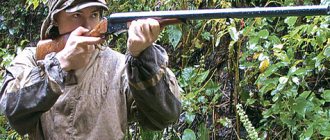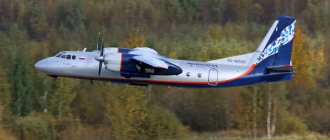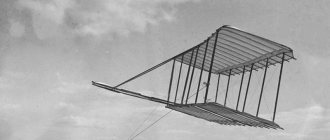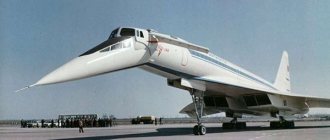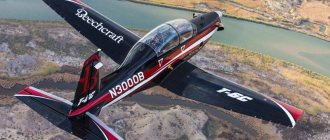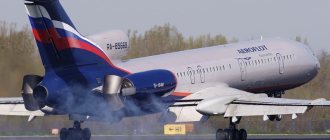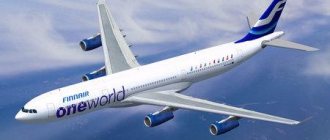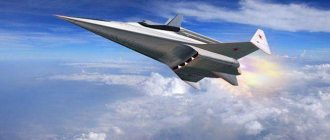The An-3 aircraft is a deep modernization of the An-2 aircraft, well known in our country and abroad, with the ASh-62IR piston engine. The An-2 biplane, which took off more than half a century ago and was built in thousands of copies, is still flying. Good takeoff and landing characteristics, reliable design and ease of operation have given this aircraft almost universality, but the time has come to take care of its replacement.
An-3 cockpit
Passenger cabin of An-3
Agricultural An-3SKh
Similar
An-24 Engine. Dimensions. Range of flight. Practical ceiling. Story
An-148 Speed. Price. Dimensions. Story. Capacity. Fuel consumption
IL-96 Speed. Dimensions. Capacity. Story. Load capacity
An-14 Pchelka Speed. Dimensions. Weight. Capacity. Story. Load capacity
IL-14 Engine. Dimensions. Story. Range of flight. Service ceiling
Yak-40 Engine. Dimensions. Capacity. Range of flight. Practical ceiling. Story
Tu-144 Engine. Dimensions. Range of flight. Practical ceiling. Story
Tu-154 Speed. Dimensions. Weight. Capacity. Fuel consumption. Story
IL-62 Engine. Dimensions. Range of flight. Practical ceiling. Story
IL-18 Engine. Dimensions. Range of flight. Practical ceiling. Story
IL-114 Engine. Dimensions. Range of flight. Service ceiling
An-2 Engine. Dimensions. Story. Range of flight. Service ceiling
Tu-114 Speed. Dimensions. Weight. Capacity. Story. Load capacity
An-3 Engine. Dimensions. Range of flight. Service ceiling
Tu-334 Speed. Dimensions. Weight. Story. Capacity. Range of flight
Yak-12 Speed. Dimensions. Weight. Story. Capacity. Load capacity
Yak-52 Engine. Dimensions. Range of flight. Service ceiling
Yak-42 Speed. Dimensions. Capacity. Fuel consumption. Story. Range of flight
Tu-204 Engine. Dimensions. Range of flight. Practical ceiling. Fuel consumption. Price
Su-29 Engine. Dimensions. Range of flight. Practical ceiling. Story
Tu-104 Engine. Dimensions. Story. Range of flight. Service ceiling
Su-31 Speed. Price. Dimensions. Story. Load capacity
IL-86 Engine. Dimensions. Range of flight. Service ceiling
Tu-134 Speed. Dimensions. Capacity. Fuel consumption. Story. Range of flight
Tu-124 Speed. Dimensions. Capacity. Weight. Story. Range of flight
An-10 Speed. Dimensions. Weight. Story. Capacity. Load capacity
IL-103 Engine. Dimensions. Capacity. Load capacity. Range of flight. Service ceiling
An-140 Speed. Price. Dimensions. Capacity. Fuel consumption. Story
Be-103 Speed. Price. Dimensions. Weight. Story. Capacity
Be-30 / Be-32K Engine. Speed. Dimensions. Range of flight. Service ceiling
ANT-20 Maxim Gorky Speed. Story. Engine. Dimensions. Range of flight
Yak-58 Speed. Dimensions. Weight. Story. Range of flight. Service ceiling
An-38 Speed. Dimensions. Weight. Story. Capacity. Range of flight
MiG-8 Duck Engine. Dimensions. Story. Range of flight. Service ceiling
Su-26 Engine. Dimensions. Range of flight. Service ceiling
Tu-110 Engine. Dimensions. Range of flight. Practical ceiling. Story
LK-1 (NIAI-1 Plywood-2) History. Dimensions. Engine. Range of flight
ANT-35 (PS-35) Engine. Dimensions. Story. Range of flight. Service ceiling
Yak-50 Speed. Dimensions. Story. Range of flight. Service ceiling
Aviatika-MAI-890 Engine. Dimensions. Speed. Range of flight. Service ceiling
Yak-55 Speed. Dimensions. Weight. Story. Range of flight. Service ceiling
IL-12 Engine. Dimensions. Story. Range of flight. Service ceiling
Airplane K-5 Engine. Dimensions. Story. Range of flight
Yak-53 Dimensions. Range of flight. Weight. Service ceiling
MAI-223 Kitten Photo. Video. Characteristics. Engine
KhAI-1 Engine. Dimensions. Story. Range of flight. Service ceiling
PS-89 (ZIG-1) Engine. Dimensions. Story. Range of flight. Service ceiling
AIR-6 Engine. Dimensions. Story. Range of flight. Service ceiling
SAM-5 Engine. Dimensions. Story. Range of flight. Service ceiling
Airplane Steel-3 Engine. Dimensions. Story. Range of flight
Airplane ANT-1 Engine. Dimensions. Story. Range of flight
Airplane K-1 Engine. Dimensions. Story. Range of flight
Airplane U-8 Little Humpbacked Horse History. Dimensions. Engine
Aircraft flight characteristics
The An-3 proved to be a serious, reliable, and efficient aircraft in flight. Compared to its predecessor, the An-2, it was much faster, more capable and more reliable. Speaking in numbers, the updated version of Antonov was 1.3 times faster and 1.5 times more carrying capacity.
In the new version of the device, the designer significantly increased the size and area of the wing: the total area of the lower and upper tail was more than seventy square meters. The span of the upper wing was more than 18 meters, the lower - 14. The length of the fuselage was almost 14 meters.
The aircraft is equipped with a TVD-20 engine, which was developed specifically for this aircraft. The engine is equipped with a seven-stage axial-centrifugal compressor, a large combustion chamber and a free two-axial stage turbine. The maximum engine power that it can develop during takeoff is 1375 horsepower.
The maximum speed of the An-3 is 255 kilometers per hour, landing speed is at least 80 kilometers. The minimum speed at which the vehicle is capable of flying, or the speed at which the vehicle begins to stall, is 60 kilometers per hour. The aircraft's fuel tanks are capable of holding 1270 kg of fuel, which provides a flight of 800-1400 km, depending on the flight altitude.
Thanks to its lightweight, durable and reliable design, the aircraft has a fairly low weight. The aircraft has a single-fin tail, and feels very confident in the air at both high and low speeds.
https://youtube.com/watch?v=LfMd1-FjP7s%3Ffeature%3Doembed
Flight performance[ | ]
- Engine - TVD-20
- Takeoff power, e.g. l. With. 1375
- Dimensions, m: upper wing span - 18.176
- lower wing span - 14,200
- length - 13.965
- height - 4.930
- top - 43.55
- length - 4.21
- maximum - 255
- with a commercial load of 1500 kg - 770
Literature
- Biplanes, triplanes, seaplanes / Per. from English T. Goroshkova. - M.: AST, 2001. - P. 50.
- Zayarin V. Turboprop successor to the An-2 // Aviation and Time. - 2004. - No. 4. - P. 4-13.
- Udalov V. Revival of the An-3 // Wings of the Motherland. - 2000. - No. 9. - P. 17.
- Yakubovich N.V. All aircraft of O.K. Antonov. - M.: AST, "Astrel", 2001. - P. 23-27.
| This article or section contains a list of sources or external references, but the sources of individual statements remain unclear due to a lack of footnotes. Statements not made may be questioned and removed. You can improve the article by providing more accurate citations to your sources. |
Notes[ | ]
- Gunston B.
The Osprey Encyclopedia of Russian Aircraft 1875-1995 - Osprey Publishing, 1995. - P. 22. - ISBN 978-1-85532-405-3 - engineer S. Nikolaev. An-3 in the air! // “Young Technician”, No. 2, 1983. Pp. 22-23
- V. Karmazin. Our bread. M., Pravda, 1986. Pp. 177
- An-3T returned from the South Pole (Russian). Tayga.info. Date accessed: February 1, 2022.
- ↑ 12
Wings of the Motherland. Vladimir Udalov. Revival of An-3. - An-3
- Nikolai Yakubovich. All aircraft are O.K. Antonova
Standard and VIP configurations
The aircraft is built using a braced biplane aerodynamic design and has an all-metal beam-stringer fuselage. The wings of the new product are straight, 2-spar, and their covering is made of polyester fabric, which increases their service life.
The glazing of the cockpit provides good visibility into the front and lower hemispheres. To facilitate official work, a fairly modern set of instruments and systems for its class is installed in the riders’ cabin.
The aircraft's avionics are represented by: navigation satellite system SN-3301, flight recorder BUR-4-1-02 with a recording capacity of 87 flight hours, flashing pulse beacons 2LA 006 433 10, emergency radio beacon ARM-406 of the COSPAS-SARSAT system.
They are complemented by control devices and an engine control system, a GMK-1AE heading system, an ARK-25 radio compass, an AGK-47US attitude indicator system, an A-611 marker receiver, an A-037 high-precision radio altimeter, a HF radio station "Yadro1-I1" and a pair of radio stations VHF band "Baklan-5".
The An-3T-07 can carry up to nine passengers and three crew members or up to 1,800 kg of commercial cargo. To comfortably accommodate passengers inside the fuselage, the aircraft is equipped with 12 soft transformable seats with the possibility of individual heating and ventilation of each of them. The presence of a good level of heat and sound insulation of the interior.
An-3 aircraft - video
https://youtube.com/watch?v=RfAC6R_6M2g%3Frel%3D0%26fs%3D1%26wmode%3Dtransparent
For this purpose, the Soviet-Polish M-15 jet aircraft with an AI-25 turbojet engine was built and tested in agricultural aviation. As the years passed, the M-15 never found its place in agricultural aviation. All production cars were scrapped. Having started development, the designers chose the most profitable option from an economic point of view - by modifying the An-2 using the maximum number of its parts and assemblies, which were well technologically mastered in production and tested in operation. The development at the design bureau was carried out in collaboration with specialists from the Krasnodar branch of the Aeroflot Institute and the Riga Institute of Civil Aviation Engineers.
ANTK im. Antonov and Polet (Omsk) tested and launched the An-3 aircraft into serial production. Currently, the basic modification is certified - An-ZT - a cargo version. The advantage of the An-3 is confirmed by the conclusion of the State Research Institute of Civil Aviation, where the aircraft is recommended for serial production: “In this standard size, due to the small number of successful aircraft projects to replace the An-2, their inefficiency in comparison with it... the main way of development of this standard size is 8-12 passengers in Russia will be an improvement in the characteristics of the An-2 due to the installation of a TVD-20 (An-3) engine on it.”
The installation of a TVD-20 turboprop engine with an AV-17 three-blade reversible propeller and an R-17 speed controller on the An-3 required a radical modification of the forward fuselage. Instead of a piston-powered “lobed nose,” the aircraft became more streamlined and graceful. Since the TVD-20 propeller rotates at a lower speed than the piston ASh-62, noise and vibration are reduced. The propeller can be braked when loading chemicals without turning off the engine, allowing the pilot to continuously use the air conditioning system and reducing the time the aircraft is on the ground. The turboprop engine runs on kerosene, which is much cheaper than aviation gasoline and safer in terms of firefighting. In addition, compressed air can be taken from the engine from the compressor for use in aircraft “needs”.
The layout of the cockpit was changed, cabin heating and ventilation systems were installed, the fuselage was lengthened and a pilot's door was installed on the left side. Electrical and flight navigation equipment has been updated. The equipment for ultra-low-volume spraying is significantly superior to similar foreign models. The installation of a lighter engine made it possible to increase the mass of the load being lifted, for the An-2 - 1300 kg, and for the An-3 - 1800 kg. At the Business Aviation 2000 exhibition held in Novosibirsk, the An-3 aircraft was awarded a large gold medal. In his class of aircraft, he set 6 world records for lifting to a height with a load. Two of them are as follows: a load of 2583 kg is raised to a height of 2000 m, and a load of 2000 kg is raised to a height of 6150 m. Several more variants of the An-3 are being developed: transport-convertible - An-ZTK and agricultural - An-ZSKH
Modifications
An-3SKh - Agricultural. It features a single-seat cabin and a 2200-liter chemical tank. First flight May 13, 1980.
An-3T - Transport. Designed to carry 1800 kg of cargo and 4 passengers. First flight February 19, 1998.
An-3T-07 - The car is equipped with 12 soft seats that fold and recline against the walls of the fuselage. Folding shelves for passengers' personal luggage, a bathroom and a drinking point are installed. To improve the appearance of the aircraft, illuminate the passenger compartment and increase comfort, square windows, heat and sound insulation, ventilation and heating are installed in each passenger seat. An additional emergency exit is being introduced on the starboard side. An-3T-07 can carry 9 passengers and 3 service personnel or 1800 kg of commercial cargo. Mixed transportation of goods and passengers at the same time is possible.
An-3T-08 - Forest patrol. Produced since 2002.
An-3T-10 - Landing. Designed for landing 12 paratroopers.
An-3TBK - Business class (“lounge”). It features rectangular double-glazed windows, a trunk, a wardrobe and a toilet.
Stronger than an American
The power plant of the model is represented by a TVD-20 turboprop power unit, equipped with a 3-blade reversible AB-17 propeller with an R-17 speed controller.
aircraft engine has a take-off power of 1375 hp. at a maximum propeller shaft speed of 1540 revolutions per minute and is capable of reaching a maximum speed of 255 km/h. In cruising mode, the aircraft speed is 230 km/h.
In cruising mode, the aircraft speed is 230 km/h
The engine air intake is located at the top of the hood and is equipped with a pleated mesh filter with dust removal channels, which helps protect the engine from foreign objects. Another innovation was the equipping of the aircraft engine with a more economical lubrication system compared to the previous model with an oil tank capacity of 40 liters instead of 125 liters. The aircraft's tractor propeller has an automatically variable pitch with a centrifugal loader, which protects it from spinning up.
The aircraft is in many ways superior to its closest opponents, the Caravan and Grand Caravan (USA). At the beginning of 2012, the Antonov State Enterprise announced the start of production of a lightweight modification of the AN-3-100 at the Kiev Aviation Plant.
Modifications of the new biplane
The new AN-3 biplane did not have a narrow focus. Over the years of its existence, it has been constantly modified. New models with good performance characteristics have been used in various fields. Today there are six modifications of the AN-3:
- AN-3T;
- AN-3SKH;
- AN-3TBK;
- AN-3T-10;
- AN-3T-08;
- AN-3T-07.
By its design, this representative of small aircraft can transport cargo over short distances within the limits of its carrying capacity. AN-3T is a transport modification of a light aircraft. The use of an unpaved runway gives him the opportunity to deliver cargo to places that are sometimes impossible even to reach by ground transport.
AN-3СХ was intended for agriculture. It performed the same work as the AN-2. This aerial worker sprayed fields with pesticides from the air to kill insects or weeds. He scattered mineral fertilizers over vast areas of farmland. Nowadays you rarely see such a younger generation “corn grower” over the fields.
AN-3TBK appeared quite recently. It is designed to transport business passengers. This version differs from the classic AN-3 in that it has double rectangular windows. There is also a wardrobe and luggage compartment. Of course, only wealthy passengers can use the services of such aircraft.
AN-3T-10 is used to deliver paratroopers to their destination and drop them. They fit 10-12 people in the cabin.
AN-3T-08 is useful in forestry. During the fire-dangerous period, when forest fires start, aircraft of this version patrol and conduct reconnaissance of forest areas.
AN-3T-07 - transport and passenger version. This modification of the aircraft can carry up to 12 people.
Unfortunately, not enough attention was paid to the production of the AN-3 aircraft. Therefore, it was only modernized a few times.
History of An-3
In the mid-60s of the last century, aviation technology began to be widely used in agricultural work; it was used not only to kill insects, but also to fertilize plants and control weeds. The volume of aerial chemical work began to rapidly increase, and in 1965, 55 million hectares were treated with the help of aircraft, and by the 80s they planned to double this figure. Under these conditions, it was necessary either to dramatically increase the fleet of agricultural aircraft, or to develop a new machine more productive than the An-2.
For a socialist economy it was easier to take the first path. Development was carried out, but very slowly, with bureaucratic delays, as a result of which the new aircraft model did not leave the testing stage almost until the collapse of the USSR.
The creators of the An-2 were confident that there were great opportunities for modifying this aircraft model. However, at that time the Ministry was dominated by the opinion of other experts that the An-2 was already outdated anarchism and it was necessary to develop a completely new airplane based on a turbojet engine for agricultural work. The result was a Soviet-Polish program to develop the M-15 agricultural aircraft based on a turbojet engine.
This aircraft not only brought economic losses to the country, but also damaged its reputation as an aircraft manufacturing power. This aircraft was poorly maneuverable, had poor flight characteristics, and also had other shortcomings. It was criticized at the 32nd Paris Air Show in 1977.
OK. Antonov took a different, unpopular path at the time, and decided to abandon the jet engine.
Back in the 50s of the last century, the idea arose to install a turboprop engine instead of a piston engine on the An-2. This made it possible to improve the flight and technical characteristics of the aircraft much better. And also the cost of processing agricultural land was significantly reduced, by about 30–40%, due to the fact that kerosene was used as fuel instead of gasoline.
However, at that time there was no engine with the necessary parameters. A little later, in the 60s, under the leadership of Glushchenkov, the TVD-10 engine was created at the Omsk Design Bureau. They wanted to use it to improve the An-2 aircraft in 1967. Then an even more powerful TVD-10A engine appeared, but all work on it was stopped due to the fact that there was a reduction in workers at the Omsk enterprise.
In 1971, a new project for the conversion of the An-2 aircraft with the TV2-117 engine was already announced. It had a larger wing span, a chassis with a front strut, a ventilation system and the most modern equipment for agriculture. This option was not implemented for a number of other reasons. However, later the An-3 project was created with 2 TVD-850 engines, but these engines were also not sent for production.
In 1974, they decided to install a TVD-10B engine on the An-2, however, soon the IL-86 project required a TVD-10 and work on the TVD-10B engines was abandoned.
This work was continued in 1978, when the TVD-20 engine began to be produced, and the aircraft itself was modified to accommodate it. In December of the same year, the aircraft itself underwent flight tests in the Turkmen SSR, and factory tests were carried out in 1981. State tests were started only in 1986 because there were certain difficulties in the manufacture of engines. In 1989, state tests were carried out by pilot A.K. Khrustitsky, and in 1991 the entire volume of tests was completed. However, the aircraft never went into production due to the collapse of the Soviet Union.
The decision to revive the An-3 was approved by the ANTK enterprise. O.K. Antonov in 1997, then preference was given to the An-3T variant, because the demand for agricultural models had fallen by that time. The airplane was modified to meet modern characteristics. The first such An-3T model was manufactured in 1998 at an Omsk plant. The first production An-3T airliner was sent to the aviation balance sheet. The An-3 aircraft was produced only in small series from 2000 to 2009. After this, serial production of the aircraft was curtailed.
In 2012, a lighter An-3-100 model was created at Kievsky, which was equipped with more modern radio and navigation equipment.
Light transport aircraft An-3T at the MAKS-1999 exhibition.
The ice moved, but floated far away
It is unknown how its fate would have developed in the future if the Ministry of Aviation Industry and the Ministry of Civil Aviation had not decided to create a new aircraft for agriculture. In an unofficial competition, 2 versions of the I-711 R.A. project received approval. Izmailova. On one plane he intended to install an AI-25 jet engine, or rather a turbojet, with a thrust of 1500 kgf, on the other - a TVD10A turboprop.
October 1971 brought good news to aircraft designer Izmailov. TsAGI specialists gave a positive assessment to his projects and recommended building a prototype. The prospect of creating a new model of jet aircraft has opened up.
However, its future fate was decided by an agreement between the USSR and the Polish People's Republic, according to which aviation equipment for agriculture was to be created, improved and produced only in Poland at an aviation enterprise in the city of Mielec. R.A. went there. Izmailov with his team to implement the I-711 project.
Together with Polish designers, Izmailov created the M-15 biplane with a turbojet engine (TRD).
After passing state tests, the M-15 was put into mass production in Poland, at an aircraft plant, where the Antonov AN-2 aircraft, which had been well proven for many years, continued to be produced.
The M-15 jet agricultural aircraft could not compete with the brainchild of the famous aircraft designer, the AN-2 biplane, for a number of reasons. He had:
- Low efficiency.
- Difficulty in operation.
- Lack of maneuverability.
- Poor takeoff and landing performance.
As a result, serial production of the M-15 ceased at 120 copies. In the Soviet Union, aircraft of this type stood idle, then they were disposed of.
Agriculture continued to require productive aircraft. The creation of the first model of an aircraft for small jet aircraft was unsuccessful. The M-15 was a failure.
O.K. Antonov and his team set out to solve the problem of increasing the productivity of aviation agricultural machinery. Oleg Konstantinovich proposed the simplest and most acceptable option - to modernize the AN-2. He did not intend to install a turbojet engine on it, but simply to give “Annushka” a different “heart”, i.e. replace a piston engine with a turboprop on an airplane. What were the prospects for this?
- The flight performance characteristics of the new aircraft were improved.
- Fuel became cheaper because... The turboprop engine uses kerosene, which has always been cheaper than gasoline.
- By replacing fuel, the cost of processing 1 hectare of farmland was reduced by up to 40%.
- It was possible to create comfortable working conditions for the crew in the cabin by installing air conditioners in it.
Aviation officials did not particularly approve of the idea of modernizing the legendary “maize”, which consisted of replacing its piston engine with a theater engine. None of the aircraft designers could offer other options, so we settled on this.
Model of the first version of An-3 with GTD-10 engine
Layout of An-3 with TV2-117S engine
It was not possible to begin the project immediately. The reason was the lack of a suitable engine. The Antonovites went through several models and settled on a modification of the TVD-10A, proposed by the Omsk Motor-Building Design Bureau. As soon as it became clear that it was this “heart” that would take root in the “organism” of the AN-2, we began to modernize it. The new vehicle received the designation AN-3.
An-ZT in the assembly shop of the Omsk Production Association "Polyot"
And again ministerial officials intervened in the matter. They considered that the selected engine did not meet modern requirements and banned its use on the AN-3. The search for something new continued.
After some time, the OMKB, together with the designers of the Antonov Design Bureau, built a more powerful turboprop engine TVD-20, which was installed on the AN-3. To install it, it was necessary to remake the AN-2 fuselage in the forward part.
When this was done, the modernized aircraft became sleek and streamlined.
Unlike the piston ASh-62, which was equipped with the AN-2, the propeller speed on the TVD-20 was lower, therefore the noise from the engine and vibration of the hull were reduced. The great advantage of the AN-3 aircraft is the ability to fly from unpaved runways. A good indicator was the acceleration time of the TVD-20 engine. It was two and a half seconds from idle to takeoff.
We need a new plane, but wait until we design it
This is approximately how officials reacted to the initiative of aircraft designers in the Soviet Union in the sixties of the last century. The country was recovering from the devastating war with Nazi Germany. The transition to peaceful life required the creation of peaceful tools, and not weapons of destruction. Indeed, during the Great Patriotic War, the entire national economy carried out military orders.
This also applied to the aviation industry. All aircraft designers worked to create new aircraft models that would outperform enemy fighters and bombers. And they managed to do this. In 1945 the long-awaited victory came. In peacetime, some design bureaus were given another task - to design aircraft for civil aviation.
In the sixties, the need for them increased, especially for lungs. Agriculture was developing, which required a large number of such aerial “hard workers” as the already legendary AN-2. It was developed in the mid-forties by the design bureau of Oleg Konstantinovich Antonov.
After passing state tests of the AN-2, which was on August 23, 1948, it was adopted by the Air Force as a transport aircraft.
However, the AN-2 brought great benefits to the national economy. Agriculture developed in the USSR, gigantic areas were sown with grain crops, which had to be fed with fertilizers, pests destroyed, and weeds controlled. This work could only be carried out on a huge scale and volume from the air.
After the AN-2 appeared in the sky above the fields, cultivating agricultural crops from the air, people began to call it a “corn farmer.” Many people now do not understand why it received such an unofficial name. Everything was explained simply. From 1953 to 1964, Nikita Sergeevich Khrushchev led the Soviet state. His favorite hobby was agriculture.
